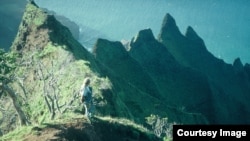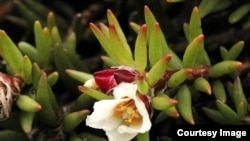After the heavy rains and high winds of two rare, large storms, Hawaii botanists are hoping the islands’ rarest plants have come through unscathed.
Thanks to its geographic isolation in the middle of the Pacific Ocean, the Aloha state is home to an incredible bounty of unique native plants, some 1,200 species, 90 percent of which are not found anywhere else in the world.
However, Hawaii has also become the endangered species capital of the United States, home to nearly 40 percent of the plants on that list.
Its natural heritage has been disappearing because of invasive plants and animals, habitat loss due to agriculture and development, and unpredictable natural events, such as hurricanes and droughts.
Rough-terrain work
Field botanist Steve Perlman has been at the forefront of protecting Hawaii’s endangered species for more than 40 years.
He is one of the state's original 'rock star' botanists - literally. In the 1970s, he pioneered rappelling down high cliffs to save the Brighamia insignis - a rare Hawaiian plant commonly known as the Alula.
"A lot of the botanists in the old days, at least for the first couple hundred years working in Hawaii, would be able to hike the ridges and the valleys and find their species. But no one had ever really looked at the cliffs," he said. "And so once I learned how to rope onto the cliffs to get to the Brighamia and pollinate them and get the seed, then I started using those same cliff-climbing techniques to get to other plants."
Now in his 60s, Perlman is still rappelling off cliffs, working to save endangered plants that have managed to establish a foothold in places where ravenous goats and pigs can’t reach them. Although his rough-terrain work is dangerous, he says it’s worth it to see a species survive.
"We know the Amazon is losing all these species," he said. "But Hawaii is losing species. There’s an extinction crisis going on here, and we’ve already had over 100 species go extinct."
Extinction prevention
After a long career as a field botanist at the National Tropical Botanical Garden, Perlman is now the statewide specialist for Hawaii’s Plant Extinction Prevention Program. The program focuses on protecting species with fewer than 50 plants remaining in the wild.
"This Plant Extinction Prevention Program is putting thousands of native plants, critically endangered plants, back out into the areas on the islands where they grew. And we’re seeing that success," he said.
Through his work, Perlman also continues to discover new species, like the Hibiscadelphus trees that he and his colleagues found growing in a remote, steep valley on the island of Maui.
His explorations often take him to pristine places, like the highest peak on the island of Moloka`i.
"It’s like being someone like a Charles Darwin who’s just gotten to come to an island that no one’s ever been to. And everything is interesting: the birds, the insects, the plants. And you’re like the first person in this kind of place, we may rediscover something old, or we may find something brand new. And so it’s like the age of discovery is not really over."
Today, with more than half of Hawaii’s native plants threatened with extinction, Perlman’s conservation work remains an inspiration for those who share his dream of making a difference.









